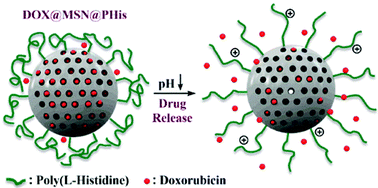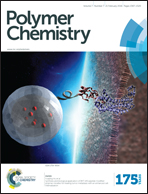pH-Sensitive nanogates based on poly(l-histidine) for controlled drug release from mesoporous silica nanoparticles†
Abstract
The design and synthesis of novel poly(L-histidine)-grafted mesoporous silica nanoparticles (MSNs) by a surface-initiated ring-opening polymerization process (ROP) is reported. Using (3-aminopropyl)triethoxysilane (APTES) to introduce primary amino groups onto the MSN outer surface that work as ROP initiators, the nanoparticles were decorated with a uniform pH-sensitive poly(L-histidine) (PHis) shell. The method applied for the MSN functionalization, guaranteed that PHis chains were not grafted inside the MSNs' nanochannels. Successful grafting of the PHis chains was confirmed by FT-IR spectroscopy, TEM and TGA, while the controlled character of the polymerization was monitored by SEC analysis. Dynamic light scattering (DLS) and zeta potential analysis were used to reveal the pH-responsive nature of the polypeptide-gated MSNs. The role of the grafted PHis chains as pH-sensitive nanogates for the MSN pores was verified by drug loading and release studies, using the model anticancer drug doxorubicin (DOX). DOX was efficiently loaded within the nanochannels of the hybrid MSN@PHis nanostructures (approximately 90%), and was released in a relatively controlled pH-triggered manner. Overall, the described materials are promising candidates as nanocarriers for potential drug delivery applications.


 Please wait while we load your content...
Please wait while we load your content...